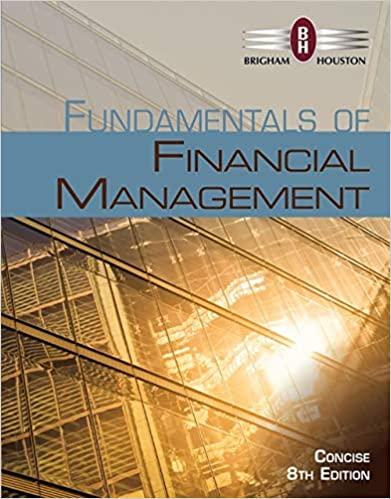EVALUATING RISK AND RETURN Bartman Industries and Reynolds Inc.s stock prices and dividends, along with the Winslow
Question:
EVALUATING RISK AND RETURN Bartman Industries’ and Reynolds Inc.’s stock prices and dividends, along with the Winslow 5000 Index, are shown here for the period 2008–2013.
The Winslow 5000 data are adjusted to include dividends.
Bartman Industries Reynolds Inc. Winslow 5000 Year Stock Price Dividend Stock Price Dividend Includes Dividends 2013 $17.25 $1.15 $48.75 $3.00 $11,663.98 2012 14.75 1.06 52.30 2.90 8,785.70 2011 16.50 1.00 48.75 2.75 8,679.98 2010 10.75 0.95 57.25 2.50 6,434.03 2009 11.37 0.90 60.00 2.25 5,602.28 2008 7.62 0.85 55.75 2.00 4,705.97
a. Use the data to calculate annual rates of return for Bartman, Reynolds, and the Winslow 5000 Index. Then calculate each entity’s average return over the 5-year period. (Hint: Remember, returns are calculated by subtracting the beginning price from the ending price to get the capital gain or loss, adding the dividend to the capital gain or loss, and dividing the result by the beginning price. Assume that dividends are already included in the index. Also, you cannot calculate the rate of return for 2008 because you do not have 2007 data.)
b. Calculate the standard deviations of the returns for Bartman, Reynolds, and the Winslow 5000. (Hint: Use the sample standard deviation formula, Equation 8.2a in this chapter, which corresponds to the STDEV function in Excel.)
c. Calculate the coefficients of variation for Bartman, Reynolds, and the Winslow 5000.
d. Construct a scatter diagram that shows Bartman’s and Reynolds’ returns on the vertical axis and the Winslow 5000 Index’s returns on the horizontal axis.
e. Estimate Bartman’s and Reynolds’ betas by running regressions of their returns against the index’s returns. (Hint: Refer to Web Appendix 8A.) Are these betas consistent with your graph?
f. Assume that the risk-free rate on long-term Treasury bonds is 6 04%. Assume also that the average annual return on the Winslow 5000 is not a good estimate of the market’s required return—it is too high. So use 11% as the expected return on the market. Use the SML equation to calculate the two companies’ required returns.
g. If you formed a portfolio that consisted of 50% Bartman and 50% Reynolds, what would the portfolio’s beta and required return be?
h. Suppose an investor wants to include Bartman Industries’ stock in his portfolio.
Stocks A, B, and C are currently in the portfolio; and their betas are 0 769, 0 985, and 1 423, respectively. Calculate the new portfolio’s required return if it consists of 25%
of Bartman, 15% of Stock A, 40% of Stock B, and 20% of Stock C.AppendixLO1
Step by Step Answer:

Fundamentals Of Financial Management Concise Edition
ISBN: 9781285065137
8th Edition
Authors: Eugene F. Brigham, Joel F. Houston




